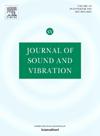Non-collocated active vibration suppression of both rough-machining and finishing in ram-type milling machine using an electromagnetic actuator
IF 4.3
2区 工程技术
Q1 ACOUSTICS
引用次数: 0
Abstract
This paper presents the non-collocated active damping system (NCADS) applied to a ram-type milling machine for achieving high-throughput machining of both rough- and finishing-milling. When installing an active damping system to practical ram-type milling machines, the available locations are limited due to the space constraints and the interference against machining processes. Therefore, it is often the case that the non-collocated configuration of the active damper becomes inevitable. Such non-collocated active damping system (NCADS) may require high force–density actuators to compensate the poor controllability, and right half-plane zeros caused by the NCADS make it challenging to maximize the active damping performance while securing the controller stability. In addition, the different vibration characteristics during the rough- and finishing-milling require the vibration control strategies adapted to the machining operations. We propose the sensitivity function shaping methods in NCADS for high-throughput operation of both rough- and finishing-milling. Using the proposed method, we increase the dominant-mode dynamic stiffness of the ram structure by 154% for rough-machining operations, and thereby increase the chatter-free cutting depth up to 3.5 mm. Also, in the high-speed finish-milling test, we reduce the retainer vibration by 58% and thereby suppress the associated beating mark on the surface profile, achieving the surface roughness reduction by 40%. The results validates the high-throughput machining performance of the proposed vibration suppression control methods in both rough- and finishing-milling.
利用电磁作动器抑制冲压式铣床粗加工和精加工非同步主动振动
提出了一种应用于冲压式铣床的非配位主动阻尼系统(NCADS),以实现粗铣和精铣的高吞吐量加工。在实际的冲压式铣床上安装主动阻尼系统时,由于空间限制和对加工过程的干扰,可用位置有限。因此,主动阻尼器的非配置往往成为不可避免的情况。这种非配置主动阻尼系统(NCADS)可能需要高力密度作动器来补偿较差的可控性,而NCADS引起的右半平面零使得在保证控制器稳定性的同时最大化主动阻尼性能成为一项挑战。此外,粗铣和精铣加工过程中不同的振动特性要求振动控制策略与加工操作相适应。我们提出了NCADS中灵敏度函数整形方法,用于粗铣和精铣的高吞吐量操作。采用该方法,在粗加工操作中,我们将滑枕结构的主模态动态刚度提高了154%,从而将无颤振切削深度提高到3.5 mm。此外,在高速精铣测试中,我们减少了58%的保持架振动,从而抑制了表面轮廓上相关的敲打痕迹,实现了表面粗糙度降低40%。结果验证了所提出的振动抑制控制方法在粗铣和精铣加工中的高吞吐量加工性能。
本文章由计算机程序翻译,如有差异,请以英文原文为准。
求助全文
约1分钟内获得全文
求助全文
来源期刊

Journal of Sound and Vibration
工程技术-工程:机械
CiteScore
9.10
自引率
10.60%
发文量
551
审稿时长
69 days
期刊介绍:
The Journal of Sound and Vibration (JSV) is an independent journal devoted to the prompt publication of original papers, both theoretical and experimental, that provide new information on any aspect of sound or vibration. There is an emphasis on fundamental work that has potential for practical application.
JSV was founded and operates on the premise that the subject of sound and vibration requires a journal that publishes papers of a high technical standard across the various subdisciplines, thus facilitating awareness of techniques and discoveries in one area that may be applicable in others.
 求助内容:
求助内容: 应助结果提醒方式:
应助结果提醒方式:


